#telesilla of argos
Explore tagged Tumblr posts
Text
2 notes
·
View notes
Text
TELESILLA OF ARGOS // POET
“She was an ancient Greek lyric poet from Argos, active in the fifth century BC. She is known for her supposed role in the defence of Argos in 494 BC, which is doubted by modern scholars. She was apparently famous in antiquity, included by Antipater of Thessalonica in his canon of women poets. In the twentieth century she inspired a poem by the imagist poet H.D.”

1 note
·
View note
Text
Women of Ancient History
I got really interested and started researching this recently! There were a lot more people than I ever expected to find. Women have been priestesses, poets, artists, Olympians, swimmers, queens, and rebels since literally the dawn of time 💪
A few notes before this: because I'm trying to steer towards women who tend to be more unknown, I purposefully didn't include Sappho, Hypatia, or Nefertiti even though they were undoubtedly important.* Two exceptions here: one is Cleopatra, because I think that the modern image of her is essentially a caricature and the real woman is much more entertaining. The other is Queen Boudica, because... I just have a soft spot in my heart for her honestly. But others, like Agnodice of Athens, were excluded because there seems to be a consensus that they probably didn't exist.
Anyway, this also goes roughly in chronological order.
*= I understand that 'well known' is going to change in different parts of the globe. For example, Queen Boudica has greater name recognition in the UK, while Ba Trieu is well known in Vietnam. Coming from the North American perspective here
Enheduanna of Mesopotamia (2286 BCE)

The world's first ever named author was a Mesopotamian woman! She was born in 2286 BCE, and was the daughter of Sargon the Great (the first ruler of the Akkadian empire). Some people think the 'daughter' part might have been figurative. Regardless, at the time she was alive they were having trouble merging the culture of Ur and the newfound identity of the Akkadian empire with the traditional Sumerian practices. One of the ways to keep the population in check was through religion- which was why Enheduanna was appointed high priestess of the moon deity. The position would have been a great honor, and given her almost divine authority. She served in this role for about forty years, during which time she wrote 42 temple hymns and three epic poems- such as "Exaltation of Inanna". She notably changed the characterizations of the local pantheon significantly- drawing them closer to humanity, and elevating certain gods (like Inanna) above their previous station. She is also credited with the first use of first person in writing. Her work was studied and copied for years after her death, and influences a lot of other literature from antiquity.
Telesilla of Argos (510 BCE)

Yet another poet! Telesilla was very sick when she was young, and prayed to the gods to restore her health. She believed that the answer was in dedicating her life to the nine muses, and produced a really large amount of work. Unfortunately, unlike Enheduanna, there is very little of it that survives. She is referenced by several different historians: Pausanius, Plutarch, Athenaeus, etc. Beyond poetry, she is most famous for her role when the Spartans invaded Argos. They had, by this point, killed a lot of Argives- and Telesilla mobilized the women in defense. There are a couple of historians who argue that it was her music, rather than Telesilla's own initiative, which inspired this response. That being said, there are Ancient Greek accounts of women throwing stones and roof tiles at invaders, as well as women/kids/elderly attempting to defend the interior of the city while the young men defended the exterior. According to worldhistory.org, "nothing inherently improbable... that her name was famous both for her written work and her exploits at Argos against the Spartans strongly suggest that the account of Telesilla leading the women of the city into battle is based on a historical event."
Artemisia I of Caria (480 BCE)
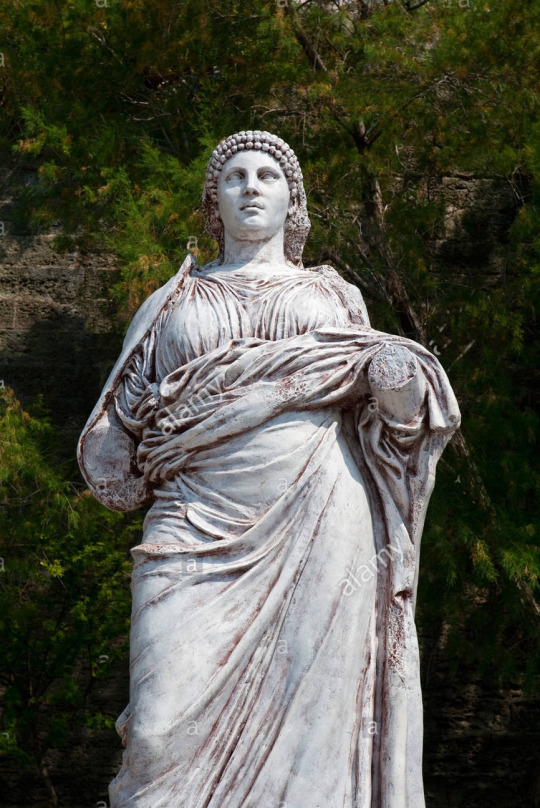
Artemisia of Caria was a woman from Ancient Persia. Why is this significant? Well, women from Ancient Persia had significantly more equality than women in many other parts of the world at the time. They had significant roles outside of the house- women could run businesses, be officers in the army, etc. That's how Artemisia got to have a significant position as one of Xerxes I's naval commanders. During this period Greece and Persia were at war, and Xerxes I was considering how to approach the Greeks. As they were considering a naval battle, Artemisia was the only one to advise against it. She basically told Xerxes to form a blockade and wait them out until they starved (!). Xerxes I didn't listen to her. Despite this, Artemisia came along for the battle on her own free will. She was very successful, sinking a Greek ship. However, her original prediction for the battle proved correct, and the Persians lost. She was pretty well honored during her own lifetime for this. Beyond that, historians (including Herodotus) mostly mention her favorably. After the battle Xerxes had her ensure his son's safety as they returned to Persia, and we *think* that she returned to Caria and continued her reign there afterwards.
Hydna of Scione (480 BCE)

You may notice that I gave the same year for Artemisia of Caria- if you did notice, good job, astute reader! There's a reason for that! While Artemisia is the Persian side, Hydna is a greek heroine from the same time period in the war (though different battles...)
There are two different versions of Hydna's story. Both agree that her father was a famous swimmer and diver named Scyllias, who taught her to swim from a young age as well. In the first version from Pausanius, her skills became needed before the battle of Artemisium. In this version she volunteers to swim ten miles with her father to the Persian ships, and then cut the ropes and anchors with a knife. The ships smacked into each other in the water, or else ran into the rocks and were destroyed- allowing the Greek forces a significantly better shot at victory. In the other version from Herodotus, her father was working for the Persians as a diver to recover treasure- while also passing information to the Greeks. Then he and his daughter sabotaged the Persian ships just before the major battle. However, in either story, Hydna's fate was unknown.
Cynisca of Sparta (300s BCE)

Cynisca was a princess who competed in the Olympic games against men (and won). Women in Sparta had more freedom than in other parts of Greece- they were allowed to own property, inherit, commit adultery, and received more education and physical training. So- Cynisca had an uncharacteristic level of freedom. She used this to her full advantage, and excelled at chariot racing. While she used a jockey, her wealthy male contemporaries also used them (ie, it wasn't a unique scenario in any way). Regardless, she won at two separate Olympic games. Her grave read "My ancestors and brothers were kings of Sparta. I, Cynisca, victorious with a chariot of swift-footed horses, erected this statue. I declare that I am the only woman in all of Greece to have won this crown."
Iaia of Cyzicus (110s BCE)

Iaia was one of several female painters mentioned by Herodotus- along with Irene, Aristarete, Timarete, etc. I chose her for this because more seems to be known about Iaia as compared to her other female counterparts. She was born in Cyzicus, and also did ivory engravings. There was a big demand for art in Rome at the time, and she was a better artist than many of her male contemporaries. To quote Pliny the Elder, "no one had a quicker hand than she in painting." Not only did she remain unmarried throughout her life, but her art was well known for choosing to center women as subjects.
Cleopatra VII of Egypt (70/69 BCE)

I know everybody already knows the basic biography of Cleopatra, so I won't get into that. I mostly just wanted to focus on her accomplishments for once, because I feel like she gets a bad rap in a lot of media even though she was arguably pretty good. She was the only pharaoh from her dynasty who bothered to read and write Egyptian, she was noted for her public speaking skills, she understood several more languages, and was educated on "mathematics, philosophy, oratory, and astronomy" (quoting history channel here). Throughout her reign she maintained a vast network of spies- not just inside Egypt either- to make the best decisions possible. She stabilized the country's economy, and when drought hit she opened the royal granaries to the public. She oversaw the construction of parts of the Temple of Hathor, as well as temples to some Greek gods. Cleopatra also expanded the Library of Alexandria after it was damaged in a fire. The woman was a highly strategic ruler.
PS: if you're interested, you should also check out her younger sister Arsinoë IV. Her story is pretty fascinating and there's a Drunk History episode about her (basically, she tried to take over Egypt at like age 15- I'll leave the rest open).
Queen Boudica of Iceni (60s AD)
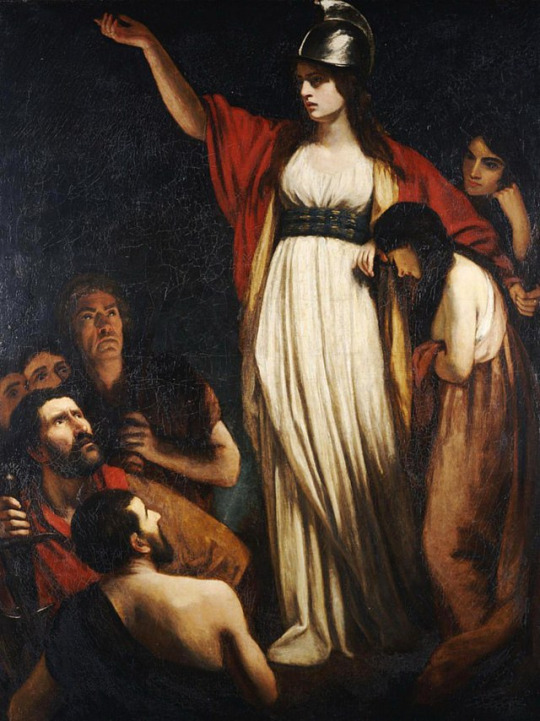
I know that she is super well known, but I've admired her since I was a little kid so she gets a spot. Boudica was the wife of Prasutagus. Everything was relatively peaceful until she was widowed, and her husband's wishes that the area be left to both Nero and his two daughters (Heanua and Lannosea) were ignored. Accounts vary about how the Romans reacted next- but Tacitus claims that Boudica was flogged, the house was ransacked, and her daughters were raped. The other Iceni locals were treated no differently and rebelled as a result, targeting the area around modern day London. They were at first very successful. Boudica reportedly told the troops "win the battle or perish: that is what I, a woman, will do; you men can live on in slavery if that's what you want." Eventually they were beaten by the Romans- while Boudica was not killed here, she reportedly took poison rather than be a Roman prisoner. I couldn't find what specifically happened to her daughters. It's a really grisly ending, but her bravery is still awe-inspiring.
Azadokht Shahbanu of Persia (240 AD)
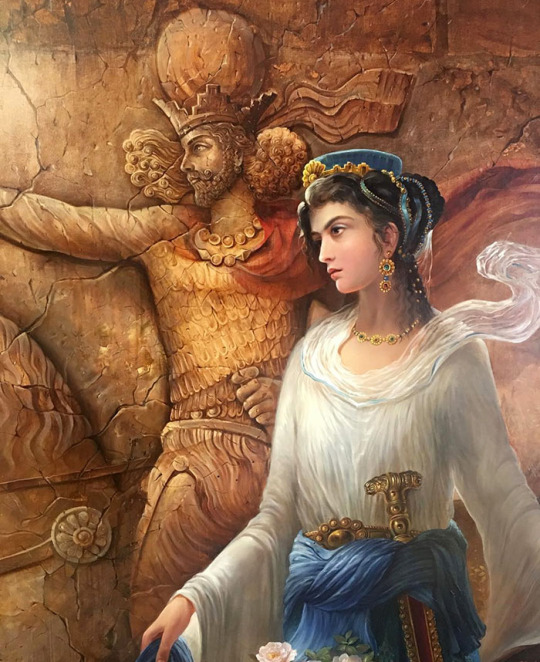
She was the wife of Shapur I. As you may recall from the section on Artemisia I of Caria, women in ancient Persia had significantly more influence than women in other parts of the world. This doesn't come into the story as much here as it did for Artemisia, though. Azadokht is here because she is thought to have highly encouraged the building of Gundeshapur, which had a teaching hospital and library. This legacy lasted for hundreds of years after her death. Traditionally it was her husband's direction which led to its building, but there's evidence that it was Azadokht who brought in Greek doctors to influence how it was run. Azadokht was also apparently very skilled at sword fighting as well.
By the way, there could probably be a whole other post of similar length about women from ancient Persia alone. These women had a unique amount of freedom and they were taking advantage of it. If you want to read more about them, here's an article called Twelve Great Women of Ancient Persia.
Zenobia of Palmyra (late 200s to early 300s AD)

For some historical context: Palmyra is in modern day Syria, and considered to be ruled by a very unstable Rome. Palmyra itself was a trading city between Persia and Rome- Zenobia herself was born a Roman citizen (interesting side note: she also claimed to be descended from Cleopatra. The truth factor in that is unfortunately dubious...). She was married to an important political figure, who was assassinated in about 266 CE. Zenobia then came to power. She started claiming parts of Roman Egypt for herself, and then started eyeing other pieces of neighboring territories- basically adding them without regard for the unstable Rome which could do nothing about it. This was until Aurelian, whose reaction to this insubordination was effectively a rampage. There are loads of different versions of what happened to her after this. However, Zenobia's court remained imprinted on historical memory + was referenced a lot afterwards.
Ba Trieu (300 AD)

Ba Trieu was born into an upper-class family. She *may* have been orphaned as a child and raised by an older brother, but we don't really know enough to say for sure. During this period the Vietnamese were under an oppressive Chinese regime, and Ba Trieu decided at age 19 that she'd had enough and was going to rebel. Her brother tried to dissuade her, and she reportedly said, "I want to ride the storm, tread the dangerous waves, win back the fatherland, and destroy the yoke of slavery. I don't want to bow down my head, working as a simple housewife." She made a shocking amount of progress in the next two years in at least 30 battles, until the Chinese finally recognized her as the serious threat that she was. Everyone agrees that she died afterwards, though stories vary about exactly how.
PS: if you're interested in other women from the Vietnamese fight against the Chinese, google the Trung sisters. They're remarkable women.
Fatima al Fihri (800 AD)
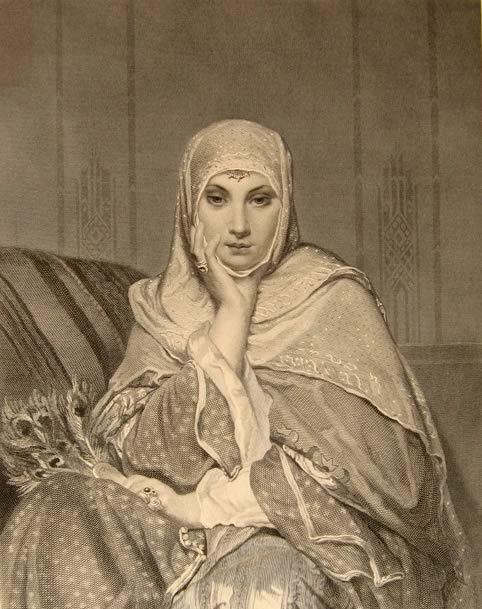
Fatima was born in modern day Tunisia, and unlike a lot of the women on this list, she actually wasn't a queen/ruler of any sort. Her father was a merchant. When Fatima inherited a lot of money from the deaths of her father/husband, she chose to use it to use her money to build a mosque. Her town was overflowing with people at this point, so it was becoming a major need. It ended up also accommodating a library and university, which I believe is still open today. Because of its age and prominence, a lot of the practices which are today associated with colleges originated here. To quote an article from Morocco world news, "for a North African Muslim woman to establish such an institution, which she opened to people of all ages, social classes, and faiths, is testament to her exceptional vision... the rest of the world has Fatima Al-Fihri, the mother of intellectuals, to thank..."
xxxxxxx
Unfortunately, that has to be all for now- there were a fair number of other women who I wanted to include here, but couldn't because they aren't 'ancient' enough. (Jigonhsasee? Shajar al-Durr? Looking at you).
I also learned sooooo much writing this so I'm a happy girl right now. But that being said, if you see any obvious inaccuracies, let me know and I'll edit it. There's a lot of cases where sources vary about what happened, so I had to pick and choose. Also, because of the quantity of women in this- and some didn't make the cut- I was only looking at 2-3 articles per person, leaving room for error. There are some cases where some people allege that the woman in question didn't actually contribute enough to the thing she's famous for. Unless I thought this belief seemed to have a lot of evidence + appeared in multiple articles, I left her in.
#women's history#history#ancient history#ancient rome#ancient greece#ancient persia#long post#herstory#feminism#Idk if this qualifies as feminist though lol
6 notes
·
View notes
Text
For the sake of completeness (at the expense of lengthening an already huge info dump) there are three other mentions I'm aware of regarding women in relation to the cult of Ares. The first is in Geronthrai, Lakonia:
"On the road from Acriai to Geronthrai is a village called Palaia and in Geronthrai itself are a temple and sacred grove that belong to Ares. Every year a festival is held in honor of the God, at which women are forbidden to enter the grove." (Paus. 3.22.6-7)
A similar notion is conveyed by a 3rd C. BCE autor, Teles (24.11), when he mentions that women are forbidden in the sanctuaries of Enyalios. Finally there is this story in Argos:
"But when Cleomenes king of the Spartans, having slain many Argives (...) proceeded against the city, an impulsive daring, divinely inspired, came to the younger women to try, for their country's sake, to hold off the enemy. Under the lead of Telesilla they took up arms, and taking their stand by the battlements, manned the walls all round, so that the enemy were amazed. The result was that they repulsed Cleomenes with great loss, and the other king, Demaratus, who managed to get inside—as Socrates says—and gained possession of the Pamphyliacum, they drove out. In this way the city was saved. The women who fell in the battle they buried close by the Argive Road, and to the survivors they granted the privilege of erecting a statue (?) of Enyalios [ἱδρύσασθαι τὸν Ἐνυάλιον], as a memorial of their surpassing valor. Some say that the battle took place on the seventh day of the month which is now known as the Fourth Month, but anciently was called Hermaeus among the Argives; others say that it was on the first day of that month, on the anniversary of which they celebrate even to this day the 'Festival of Impudence' [Hybristika], in which they clothe the women in men's shirts and cloaks, and the men in women's robes and veils." (Plut. De mul. uir. 4.245c-e) (for different accounts see Paus. 2.20.8-19 and Herodotus 6.77)
"Because of Telesilla's victory, Ares is numbered at Argos among the gods of the women" (Lucian Erot. 30)
For further reading and discussion on (sadly very unlikely) historical authenticity see Women, War, and Warlike Divinities F. Graf, Women and War in Antiquity S. Georgoudi, Teaching by example: aetiology in Plutarch’s De Mulierum Virtutibus R. Benefiel and The Argive Women, Beards and Democracy N. Bershadsky among others.
Regarding these stories concerning the cult of Ares and women, we encounter a theme of alienation between the two parties. Women generally do not mix with war. Either the god (presumably) does not allow them in his sacred spaces, or, in the legends where women are led by virtuous figureheads (Telesilla in Argos and Marpessa in Tegea) and save the city, they are either "granted the privilege" of worshipping him (Argos), or they themselves assert that privilege and likewise exclude the men (Tegea).
In addition to all this, as always, it’s important to try to avoid generalizations when it comes to local accounts. Most of the time there's no mention of any specific relationship between women and Ares, in either direction. Generally women neither seemed to be actively excluded from his rites, nor held a place of significant importance.
ARES IS NOT THE PROTECTOR OF WOMEN IN GREEK MYTHOLOGY.
He is never presented as such in any source, there is no evidence such a role was ever assigned to him in any account, and as far as I'm aware this popular yet unattested assertion is born from the echo-chambers of tumblr. In fact quite the opposite could be argued. TW for sexual assault.
This baffling claim seems to originate from a sort of shallow examination of the way Ares "behaves in myth", and the following arguments are the most frequently presented:
1. Ares protects his daughter Alkippe from assault, and is therefore morally opposed to rape. (Apollodorus 3.180, Pausanias 1.21.4, Suidas "Areios pagos", attributed to Hellanikos)
Curiously this argument is never applied to, among other examples: Apollo for defending his mother Leto from Tytios, Herakles for defending Hera from Porphyrion (or his wife Deianeira from Nessos), or Zeus for defending his sister Demeter from Iasion (in the versions where he attacks her), etc. The multiple accounts of rape of the previously mentioned figures did not conflict with these stories in greek thought: they're defending family members or women otherwise close to them. This sort of mentality is not uncommon even in contemporary times, e.g. a warrior may have no ethical problem killing men, but would not want his own family or loved ones to be killed. The same goes here for sexual assault.
2. There are no surviving accounts of Ares sexually assaulting anybody.
The idea that the ancient greeks pictured that, among all the gods, Ares was the only one who shied away from committing rape borders on ridiculous. In this case absence of evidence is not evidence of absence.
The majority of surviving records regarding Ares' unions are presented in a genealogical manner, and do not go into details on their nature. This is the case for most works of mythography, where specifics of sexual encounters are to be found elsewhere. However, common motifs present in other accounts of rape also appear in stories concerning Ares' relationships, e.g. tropes like shape-shifting/the use of disguises, the victim being a huntress, secrecy, and the disposal of the concieved child, are to be found in the stories of Phylonome and Astyoche respectively:
Φυλονόμη Νυκτίμου καὶ Ἀρκαδίας θυγάτηρ ἐκυνήγει σὺν τῇ Ἀρτέμιδι: Ἄρης δ᾽ ἐν σχήματι ποιμένος ἔγκυον ἐποίησεν. ἡ δὲ τεκοῦσα διδύμους παῖδας καὶ φοβουμένη τὸν πατέρα ἔρριψεν εἰς τὸν Ἐρύμανθο
"Phylonome, the daughter of Nyktimos and Arkadia, was wont to hunt with Artemis; but Ares, in the guise of a shepherd, got her with child. She gave birth to twin children and, fearing her father, cast them into the [River] Erymanthos." (Pseudo-Plutarch, Greek and Roman Parallel Stories, 36)
οἳ δ᾽ Ἀσπληδόνα ναῖον ἰδ᾽ Ὀρχομενὸν Μινύειον, τῶν ἦρχ᾽ Ἀσκάλαφος καὶ Ἰάλμενος υἷες Ἄρηος οὓς τέκεν Ἀστυόχη δόμῳ Ἄκτορος Ἀζεΐδαο, παρθένος αἰδοίη ὑπερώϊον εἰσαναβᾶσα Ἄρηϊ κρατερῷ: ὃ δέ οἱ παρελέξατο λάθρῃ: τοῖς δὲ τριήκοντα γλαφυραὶ νέες ἐστιχόωντο.
"And they that dwelt in Aspledon and Orchomenus of the Minyae were led by Ascalaphus and Ialmenus, sons of Ares, whom, in the palace of Actor, son of Azeus, Astyoche, the honoured maiden, conceived of mighty Ares, when she had entered into her upper chamber; for he lay with her in secret" (Homer, Iliad 2. 512 ff)
In neither of these cases is a verb explicitly denoting rape used, though it is heavily implied by the context. The focus of the action is on the conception of sons, the nature of the interaction is secondary.
Other examples are found among the daughters of the river Asopos, who where (and here there's no confusion) ravished and kidnapped by different gods to different parts of the greek world, where they found local lines through children borne to their abductors and serve as local eponyms. Surviving fragments from Corinna of Tanagra tell:
"Asopos went to his haunts . . from you halls . . into woe . . Of these [nine] daughters Zeus, giver of good things, took his [Asopos'] child Aigina . . from her father's [house] . . while Korkyra and Salamis and lovely Euboia were stolen by father Poseidon, and Leto's son is in possession of Sinope and Thespia . . [and Tanagra was seized by Hermes] . . But to Asopos no one was able to make the matter clear, until . . [the seer Akraiphen reveals to him] 'And of your daughters father Zeus, king of all, has three; and Poseidon, ruler of the sea, married three; and Phoibos [Apollon] is master of the beds of two of them, and of one Hermes, good son of Maia. For so did the pair Eros and the Kypris persuade them, that they should go in secret to your house and take your nine daughters." (heavily fragmented papyrus. Corinna fr. 654)
"For your [Tanagra's] sake Hermes boxed against Ares." (Corinna fr. 666)
It seems that, similar to the myths of Beroe or Marpessa, the abducted maiden is fought over by two competing "suitors", and though we can infer that the outcome of the story is that Hermes gets to keep Tanagra, apparently by beating Ares in a boxing match, we don't actually know what happened or how it happened. In any case, Ares does mate with another daughter of Asopos, Harpina, who bears him Oinomaos according to some versions (Paus. 5.22.6; Stephanus Byzantium. Ethnica. A125.3; Diodorus Siculus 4. 73. 1). There is little reason to suppose that this encounter wasn't pictured as an abduction like the rest of her sisters.
The blatant statement that each of his affairs was envisioned as consensual is simply not true.
3. He was worshipped under the epithet Gynaikothoinas "feasted by women"
This was a local cult that existed in Tegea, the following reason is given:
"There is also an image of Ares in the marketplace of Tegea. Carved in relief on a slab it is called Gynaecothoenas. At the time of the Laconian war, when Charillus king of Lacedaemon made the first invasion, the women armed themselves and lay in ambush under the hill they call today Phylactris. When the armies met and the men on either side were performing many remarkable exploits, the women, they say, came on the scene and put the Lacedaemonians to flight. Marpessa, surnamed Choera, surpassed, they say, the other women in daring, while Charillus himself was one of the Spartan prisoners. The story goes on to say that he was set free without ransom, swore to the Tegeans that the Lacedaemonians would never again attack Tegea, and then broke his oath; that the women offered to Ares a sacrifice of victory on their own account without the men, and gave to the men no share in the meat of the victim. For this reason Ares got his surname." (Paus. 8.48.4-5)
As emphasised by Georgoudi in To Act, Not Submit: Women’s Attitudes in Situations of War in Ancient Greece (part of the highly recommendable collection of essays Women and War in Antiquity), "it is not necessary to see the operation of an invitation in the bestowal of the epithet Γυναικοθοίνας on Ares". The epithet is ambiguous, and can be translated both as "Host of the banquet of women" or "[He who is] invited to the banquet of women". In any case no act of divine intervention occurs, and the main reason for the women's act of devotion lies principally in recognising their decisive role in the routing of the Lakedaimonians. It's they who preside/participate in the feast of war, the men are excluded.
Also this a local epithet that isn't found anywhere else in Greece. As such it would be worth reminding that not every Ares is Gynaikothoinas, in the same way not every Zeus is Aithiopian, not every Demeter Erinys, and not every Artemis of Ephesos.
4. He was the patron god of the Amazons
He was considered progenitor of the Amazons because of their proverbial warlike nature and love of battle, the same reason he was associated with other "barbaric" tribes, like the Thracians or the Scythians. In this capacity he was also appointed as a suitable father/ancestor for other violent and savage characters who generally function as antagonists (e.g. Kyknos, Diomedes of Thrace, Tereos of Thrace, Oinomaos, Agrios and Oreios, Phlegyas, Lykos etc.). Also he was by no means the only god connected with the Amazons (they were in fact especially linked to Artemis, see Religious Cults Associated With the Amazons by Florence Mary Bennett, if only for the bibliography).
Similarly, Poseidon was considered patron and ancestor of the Phaiakians mainly because of their mastery over the art of seafaring (and was curiously also credited in genealogies as father to monsters and other disreputable figures).
On another note I have found no sources that claim he taught his amazon daughters how to fight, as I've seen often mentioned (though I admit I'd love to be proven wrong on that point).
5. Finally, the last reason Ares could never be portrayed as a protector of women is because of his divine assignation itself
The uncountable references to his love of bloodshed and man-slaying don't just stop short of the battlefield, but continue on to the conclusion and intended purpose of most waged wars in antiquity: the sacking of the city. The title Sacker of Cities as an epithet of Ares (though it is by no means exclusive to him) is encountered numerous times and in different variations (eg. τειχεσιπλήτης or πτολίπορθος), and the meaning behind the epithet is plain. Though it is hard to summarise without being reductionist, the sacking of a city entails the plundering of all its goods, the slaughtering of its men, and the sistematic raping and enslavement of the surviving women (to name only a small few of the literary references see The Iliad, The Trojan Women or The Women of Trachis). There is little need to emphasise that war as concieved of in ancient greece, especifically the brutal aspects of war Ares is most often associated with, directly entailed sexual violence against women as one of it's main concerns. The multiple references to Ares being an unloved or disliked deity are because of this, because war is horrifying (not because his daddy is a big old meany who hates him for no reason, Zeus makes very clear the motive for his contempt in the Iliad (5. 889-891): "Do not sit beside me and whine, you double-faced liar. To me you are most hateful of all gods who hold Olympos. Forever quarreling is dear to your heart, wars and battles.")
Ares was only the protector of women inasmuch as he could be averted or repelled (e.g. surviving apotropaic chants):
"There is no clash of brazen shields but our fight is with the war god, a war god ringed with the cries of men, a savage god who burns us; grant that he turn in racing course backward out of our country’s bounds, to the great palace of Amphitrite or where the waves of the thracian sea deny the stranger safe anchorage. Whatsoever escapes the night at last the light of day revisits; so smite him, Father Zeus, beneath your thunderbolt, for you are the lord of the lightning, the lightning that carries fire." (Shophocles, Oedipus Tyrannos, 190-202)
"And let no murderous havoc come upon the realm to ravage it, by arming Ares—foe to the dance and lute, parent of tears—and the shout of civil strife." (Aeschylus, Suppliant Women 678)
~~~~~
All that being said, this is a post about Ares as conceptualized and attested in ancient sources, made specifically in response to condescending statements about how "uhmmm, actually, in greek mythology Ares was a super-feminist himbo who was worshipped as the protector of women and was hated by his family for no reason, you idiot". It is factually incorrect. HOWEVER, far be it from me to tell anyone how they have to interact with this deity. Be it your retellings, your headcannons or your own personal religious attachments and beliefs towards Ares, those are your own provinces and prerogatives, and not what was being discussed here at all (I personally love art where Ares and Aphrodite goof around, or retellings where he plays with his daughters, or headcannons that showcase his more noble sides, etc.)
~~~~~
I've seen that other people on tumblr have made similar posts, the ones I've seen were by @deathlessathanasia and @en-theos . I have no idea how to link their posts, but they're really good so go check them out on their pages!
#greek mythology#greek myths#greek gods#hellenic deities#tagamemnon#ares#ares greek god#ares greek mythology#ares deity#tw rape#Someone read “god of rebellion” on theoi and ran with it#it's in reference to him presiding over the violence of riots and civil disturbances#not as protector of the downtrodden and disenfranchised#Still#I firmly believe everyone is entitled to their own belief systems and political ideals#as long as they aren't hurting anyone#it's a basic human right#but claiming ares was *historically* a “protector of women or of the abused” is just not true#it's misinformation#and misinformation hurts#checking primary sources is the only way to make sure you're not repeating someone else's headcanons
1K notes
·
View notes
Video
youtube
TELESILLA was a Greek lyric poet who lived in Argos in the fifth century BCE. Along with the famous poet Sappho, Telesilla was named as one of the Nine Female Lyric Poets of Greece, and is known for both her lyric poetry (even though only two lines survive) and for her courage as the defender of Argos against Sparta.
33 notes
·
View notes
Link
“No action taken by women for the common good is more famous than the conflict against Cleomenes by the Argive women, which they fought at the instigation of the poetess Telesilla. When Cleomenes king of Sparta had killed many Argives (but not, as some have imagined, Seven thousand, seven hundred, and seventy-seven) and marched against the city, an impulsive courage, divinely inspired, impelled the younger women to defend their country against the enemy. With Telesilla as general, they took up arms and made their defense by manning the walls around the city, and the enemy was amazed. They drove Cleomenes off after inflicting many losses.”
#telesilla of argos#ancient greece#ancient history#antiquity#women poets#women in history#warrior women#women's history#history#war#military history#5th century BCE#badass women#women in war#greece#greek history
34 notes
·
View notes
Photo

Telesilla - Pencil on paper
#artists on tumblr#telesilla of argos#drawing#art#painting#illustration#illustrators on tumblr#sketchbook#ancient greece#mythology#ancient history#mystis art
4 notes
·
View notes
Text
Desire listens intently, nodding their understanding. They held no expectations over Lucifer and hence wouldn't push any further than he was willing to go. As he talks about Maze and Chloe; Desire feels no envy. If anything, they're glad they were there for the other.
"I'd have liked to meet Chloe, too. You said your powers didn't work on her...Mazikeen too. I'd like to meet them. They sound very special to you." they notice a stray curl, instantly reaching up to twirl it around their little finger before pressing letting it fall loose once more. They repeat the process, like a cat with a piece of yarn.
It's their turn now, they suppose. It's been so long, though, since last they had any meaningful connections to anyone. Forever were they on the hunt; giving humans the nudges they had to to chase their desires.... They often forget just how lonely they are. They've not thought about it recently though, which has been a nice reprieve. Lucifer is to thank for that. Finally letting go of the other's hair, they let their hand fall, and rest their head against his shoulder. This bit's hard. Not only because they don't like talking about things that hurt -- but also because their memory is so abhorrently bad, they don't remember much of the last person they were with.
" It's been....so long. I had a relationship with a woman from Argos. Her name was Telesilla. She was feisty....and a poet " An understatement, they've forgotten how their influence caused her be so passionate she fought in a war. Nor do they remember how that changed so little for the women. She's but a name on their lips now; and they hate that they can't remember more of her.
"--- Nobody else. Not until you. "
Details would certainly be crossing a line; even if he still would never regard Dream as anything more than an ex who had fobbed him off in a moment he truly needed him. He was an adult about it now; had taken him a long time to get to that stage, a lot of distance, but it seemed as though he was more capable of being an reasonable about it all moreover than how Dream was dealing with it all. Still; as he tilts his head somewhat to Desire, he is tempted.
But he doesn't want to increase the animosity between them, and so he would keep the details to himself. Would do, unless both Dream and himself agreed to finally express them. A time that - he very much doubted - would ever come about.
"It was a really long time ago. Before humanity was created; before I fell from Heaven." A name of a place that still left a bitter taste in his mouth; "Which is why it's ridiculous that he still seems to care so much. But I'm not going to go into more details, not without his permission. Which I doubt he'll ever give."
And then came the question of other past relationships, and he chuckles, softly, at the thought. "I haven't been close to many, but I suppose the most notable are Chloe and Mazikeen. Chloe, a human - she died a long time ago. My powers didn't work on her, it was... interesting." He frowned, faintly, then gave Desire a raise of an eyebrow. "And Mazikeen; Maze, I took them with me when I left Hell. They're a demon; one of my most trusted. We're friends, now - just friends. You could even meet them, if you like."
#& * is this the sweet sound that call the young sailors // desire#ordinariums#desires type is people who defy customs and fight for freedom#feegle don't look
7 notes
·
View notes
Text
my sexual orientation is when women in ancient greece and rome become warriors and kick the shit out of men who are completely surprised and terrified by their military prowess
880 notes
·
View notes
Text
Telesilla the Armed Lyric Poet

Telesilla of Argos was a fifth century lyric poet famed for her work and her brave deeds. Named by Antipater among one of the nine lyric poets (though differing from the generally accepted list of nine) she was also responsible for creating the metre of poetry named after her, the Telesillean Metre.
These are the divinely tongued women who were reared on the hymns of Helicon and the Pierian Rock of Macedon: Praxilla, Moiro, Anyte the female Homer, Sappho the ornament of the fair-tressed Lesbian women, Erinna, renowned Telesilla, and you, Corinna, who sang of Athena’s martial shield, Nossis the maiden-throated, and Myrtis the sweet-voiced, All of them fashioners of the everlasting page. Nine Muses Great Ouranos bore, Nine likewise Gaia, to be a joy undying for mortals. (Antipater, Anthologia Palatina 9.26)
From a young age Telesilla was often sickly and so consulted the gods on how to restore her to health. An oracle declared she should devote herself to the Muses, which began her study and love of poetry and music.
Only one direct fragment of her work remains consisting of more than one word:
Now, girls, when Artemis
was fleeing from Alpheus...
According to Pausanias, in 494-493BCE when the Spartans attacked and slaughtered all the Argive fighting men, Telesilla rallied the too-old and too-young as well as the slaves and sent them to the walls of the city to stand in defence. She then armed all the women and stood ready to fight off the invading Spartans, saving Argos.
Herodotus (6.77) recorded an oracle of Apollo that king Kleomenes I received regarding the battle:
When woman wins the victory and drives out man, she shall have glory in Argos and women tear their cheeks.
Plutarch (Moralia, 245c-f) recounts the story of Telesilla leading the women in battle as well, but also:
After the city was saved, they buried the women who had fallen in battle by the Argive road, and as a memorial to the achievements of the women who were spared they dedicated a temple to Ares Enyalius.
Pausanias describes a statue of Telesilla outside the sanctuary of Aphrodite in Argos. The poet is standing, looking down at a helmet she holds in her hands, readying for battle, with the books of her poetry at her feet. Some say this is actually a statue of Aphrodite Areia, but this does not explain the books. One could perhaps say that the statue was built to show that Aphrodite of War inspired Telesilla and the women of Argos to take up arms against Sparta.
While scholars don’t doubt that the battle took place, and perhaps the remaining people of Argos did what they could in a last ditch effort to save the city, there is some doubt whether Telesilla herself defended the city with the women, or if perhaps it was her poetry that inspired the people. This is partially because Herodotus, who loves to spin stories, made no mention of Telesilla when recounting the Spartan assault on Argos.
Though only two fragments and a handful of quotations exist of her poetry now, Telesilla’s work and her fantastical tale of defending Argos with the women was still in circulation by the second century AD, 700 years after her death.
A Reversal of Gender Roles
In memory of the battle and the lives lost, the Argives celebrated the solemn festival Hybristica at the new moon in the Argive month Hermaes. Plutarch called this a “sacred rite of incivility” where women would wear men’s clothes and cloaks, and men wore veils and petticoats. Supposedly the women would also insult the men and treat them with inferiority for the entirely of the festival. The festival was said to be in honour of Aphrodite as a goddess, a god, or both, to represent the reversal of classic gender roles and dress.
As all the men of prime age in Argos had been slain, there was a significant change in the gender and social roles in the city immediately following the battle. Plutarch goes on to say:
To restore the balance of the sexes in the city, they did not (despite Herodotus' claim) marry the women to slaves, but to the best men in the surrounding towns, whom they made citizens of Argos. The women appeared not to show respect for their husbands and despised them when they slept with them as if they were inferior, so they made a law that says that women who have beards must spend the night with their husbands.
“Women who have beards” likely refers to the women who followed Telesilla into battle, thereby taking on the role of a man.
📜
Sources:
Timeline
Project Continua
Plutarch
Wiki Hybristica
Women Writers of Ancient Greece and Rome by Ian Malcolm Plant, pg 33-35
World History Encyclopedia
91 notes
·
View notes
Text
Telesilla, the “Antique Joan of Arc”
In the first volume of the Loeb Classical Library’s Description of Greece by Pausanias, the author of the notes and English translation, W.H.S. Jones, gives us “A Few Synonyms,” as they call the section. The edition is from 1928, so “synonym” is a bit broader of a term in that it means “functionally similar words with nuance.” Anyway, in the section for graven image synonyms, he notes that Pausanias uses the word ἕδος (hedos,“seated statue”) exactly once. Naturally, I had to check it out and according to Pausanias (2.20.8) it’s one of Aphrodite in Argos, looming above a stele (essentially an aesthetic, non-supporting column) featuring the lyric poetess Telesilla, who Pausanias goes on to say that, after Argos was depopulated of fighting men, armed the Argive women to successfully defend the city against the Spartans (2.20.9-10).
A lot of the literature calls her an “Antique Joan of Arc,” and for good reason—she and the women she arms:
“were not fear-struck by their war cry (ἀλαλαγμῶ, alalagmō, onomatopoeic; fun fact, Ares was called Alalaxius, “god of the war cry”) but received their attack and fought valiantly (ἐρρωμένως, errōmenōs, implies both inner and outer strength and good health, meaning that Telesilla and the Argive women were, if not winning, at least successful in repelling the siege).” Of course, male Greek author that he was, Pausanias had to hedge and say the Spartans withdrew from a lose-lose situation in which they would either ingloriously slaughter the women fighters or, inconceivably worse, lose to women.
Herodotus tells a more Spartan-friendly story in which, under the lead of Cleomenes, the Spartans killed most of the Argive fighting force, burned a very sacred grove, and went home without sacking Argos. Herodotus says he didn’t capture the city either because he was bribed or, according to Cleomenes himself, basically felt he’d done enough, but Herodotus refuses to commit to any explanation in particular.
Of issue is also the Delphic oracle that predicted the outcome of the battle, interpreted differently by Pausanias and Herodotus, even though Pausanias says he’s quoting Herodotus when he writes, “But when the woman having defeated the man drives him out and great glory is won in Argos, there will still be at that time many women of the Argives with both cheeks torn in grief.” So the women led by Telesilla are victorious, but many of them lost their husbands in the battle preceding the siege. But the text of Herodotus that we have adds “And someone from the men born afterward will say, ‘a terrible, three-coiled snake was destroyed, tamed by a spear.’” In Herodotus, it’s not that woman beats man, but that the grammatically feminine “Sparta” defeats the grammatically masculine “Argos.” As for the snake thing... it’s complicated. Pausanias himself describes the area around Argos as having a shrine to “Pythian Apollo,” that is, Apollo who killed the serpent Python, literally “Rotter.” He also says he was excited to see the tomb of Aepytus, a former sovereign of Arcadia (right next door to Argos), mentioned in the Iliad by Homer (2.604) as being right beside Mount Cyllene. Pausanias says that Aepytus was killed by a sēps, some kind of snake, and that a nearby mountain was named Sepea for it (8.4, 15, 16). Now if there’s a local shrine of Pythian Apollo, I’d say the word sēps is related to sēpō, from which we get sepsis, meaning it’s a local Argive translation and tradition of “Rotter.” It would be massively ironic to have Apollo’s Delphic oracle, named the Pythia after Python, to call Argos a “snake” in reference to their own Pythian tradition. W.W. How and J. Wells in their notes on the oracle in Herodotus explain the word for “three-coiled” as being metrically easier to work with than the intended “coil-less,” but it could refer to any three of the mountains of northern Arcadia bordering on Argolis.
We are told by W.H.S. Jones, W.W. How/J. Wells, and A Dictionary of Greek and Roman Biography and Mythology (ed. William Smith) that Telesilla, though rad as hell, is probably a later addition to the story, as Herodotus is a much earlier source than Pausanias. We also know from his later treatment of Artemisia—a Greek commander fighting for Persia and played by Eva Green in the inane second 300 movie—that although being a male Greek author he isn’t unwilling to portray women in fighting roles. Of course, the story of Telesilla is in the context of Greek-on-Greek warfare, whereas Artemisia’s being with the Persians would be a betrayal of Greece. Just as Romans thought the Greeks were effeminate, the Greeks thought the Persians were effeminate and Herodotus may have been more willing to tell of Artemisia as evidence of Persian effeminacy in contrast to Greek manliness. Either way, Telesilla appears to be a blend of the historical Argive poetess and some ancient and long-forgotten war goddess (pre-Greek or eastern), invented to account for how Sparta and Argos both technically won and thereby fulfilled the Delphic oracle—all because Sparta pulling a drive-by without capturing or at least sacking Argos sounds rather improbable. Until, of course, you consider one of the modern sources above, ADG&RB&M, which notes in the entry for Cleomenes that “we must remember the Spartan incapacity for sieges.”
An ancient mythological enigma that boils down to the simple tactical fault of an otherwise powerful force.
68 notes
·
View notes
Note
In your opinion what are the most influential women in Ancient Greek history?
For sure Hypatia, Agnodice of Athens, Sappho, Arete of Cyrene, Telesilla of Argos, and god there is so many more, ancient greek women were incredible
19 notes
·
View notes
Text
Classical Greek Adventuresses!
So for as long as I’ve been using Hero Forge, I’ve wanted to see more ancient-world aesthetics. And while I’ve managed to design some Legionary and Gaul minis, I’ve always felt too limited in ancient apparel to explore Classical Greek minis until now. But with the release of two exomis tunic tops and a leg wrap, I’ve finally had the chance to go nuts with the aesthetic. Delightfully, the top works really well with most of the skirts and dresses Hero Forge has to offer. As such, I went ahead and designed adventuresses for each of the twelve D&D classes. (Now if they’d give us a linothorax design and proper Greek helmets, I’d love them forever...) @weareadventurers
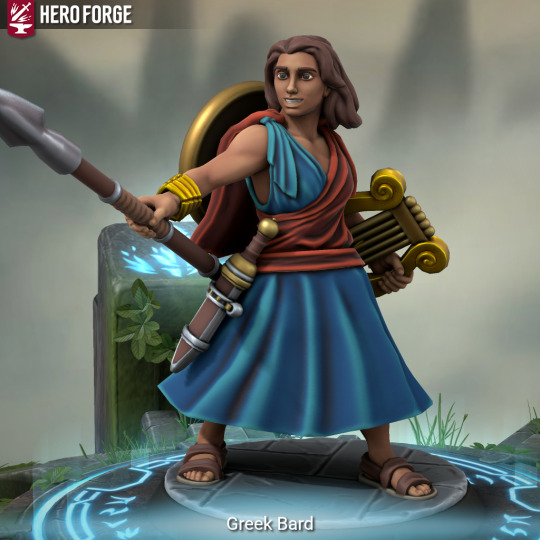
Klyte the bard, daughter of the Muse Calliope. From the city of Oreos on the island of Euboea, Klyte is very much a free spirit. Equally skilled with a lyre, a song, or a spear, she and her friends have traveled much of Greece and Ionia. A lover of food and fun and heroism, she revels in seeking adventure and wooing beautiful men and muscular women. https://www.heroforge.com/load_config%3D14920803/
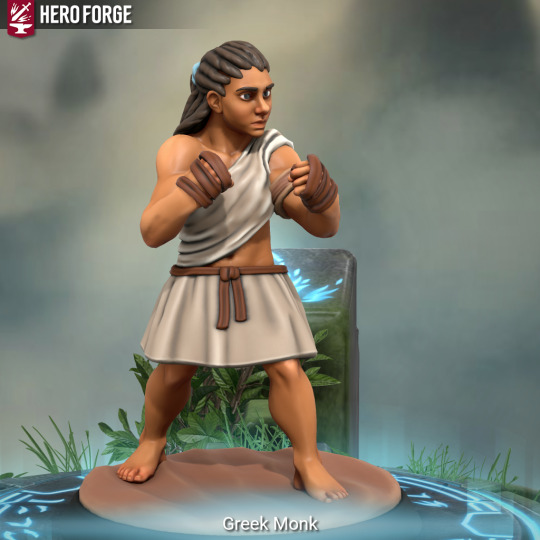
Andromakhe the monk, granddaughter of Amphictyonis. Though she grew up in Athens, she was born in the Attic city of Larion. A wrestler, boxer, and pugilist, Andromakhe is deadlier with bare fists than most warriors are with sword and spear. Though married once, she’s rarely found enjoyment in the arms of men or women, preferring travel, study, philosophy, good food, and strong wine. https://www.heroforge.com/load_config%3D14928391/
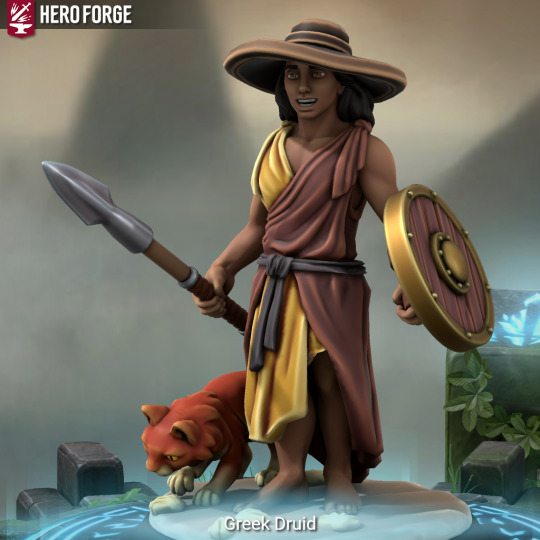
Thetis the druid, a mortal daughter of Persephone and Hades. Born during the summer, Thetis grew up helping her mother with spring plantings and fall harvests, falling in love with the magic of nature. Though she’s spent little time in the underworld, she gets along well with her father and considers Thanatos and Charon her uncles. Her favorite activities include traveling and spending time at the beach with her wife Xylia and their cat. https://www.heroforge.com/load_config%3D14924362/
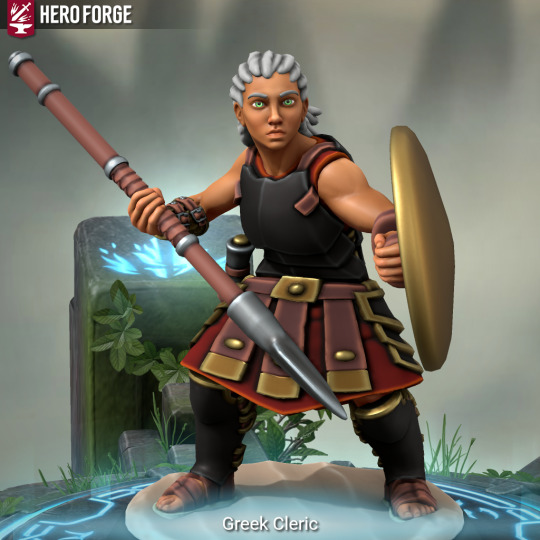
Zeuxo the cleric, transgender granddaughter of Zeus. Zeuxo is a veteran hoplite and a dedicated priestess of Hera, despite being descended from one of Zeus’s by-blows. Originally from Argos, Zeuxo chose the life of adventure and travel somewhat later in life, enticed by Klyte’s stories and songs and tits. https://www.heroforge.com/load_config%3D14922004/
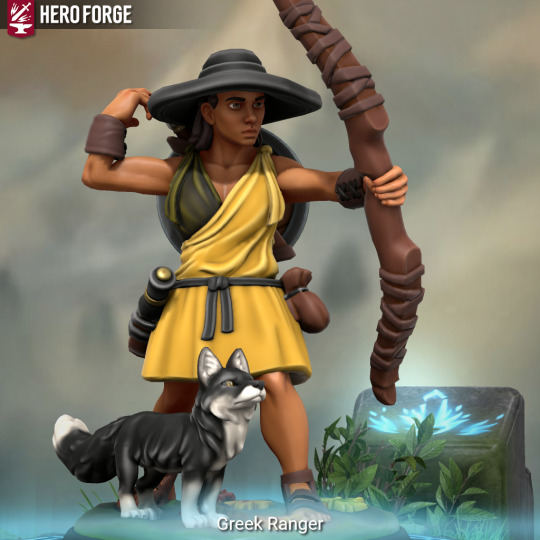
Korrina the ranger, daughter of Britomartis and huntress of Artemis. A Cretan from a township near Kydonia, Korrina has spent much of her life traveling as a huntress, scout, and mercenary toxotes. Though she cares about her friends and finds enjoyment in the arms of strong women, she has always preferred the company of animals to people and the quiet of nature to the bustle of city life. https://www.heroforge.com/load_config%3D14923271/
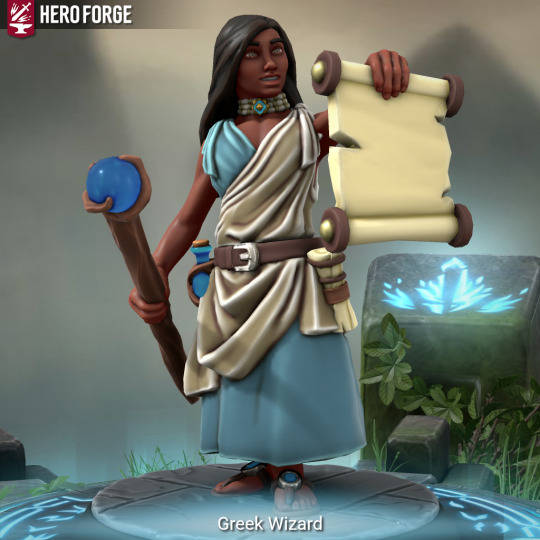
Telesilla the wizard, granddaughter of Triton. Born to a Phoenician mother, Telesilla specializes in water magic and has spent most of her life at sea. Infinitely comfortable aboard ships and with an inherent ability to breathe underwater, she has seen parts of the Aegean sea floor that other mortals can only imagine. Though she loves traveling and cares about her friends, Telesilla frequently thinks of giving it all up to spend more time with her Nereid girlfriend. https://www.heroforge.com/load_config%3D14940405/
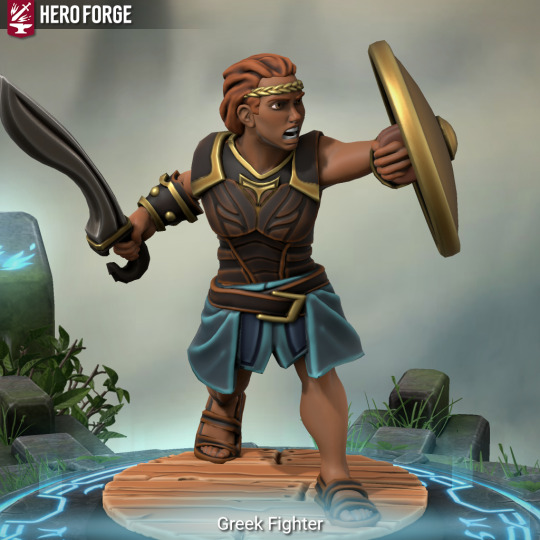
Xylia the fighter, daughter of Arethusa the nymph of spring. Born in Sicily, Xylia fought as a marine aboard Syracusan triremes before meeting and falling in love with the druid Thetis. Xylia forever left the life of a soldier for the life of a wanderer to stay at Thetis’s side. https://www.heroforge.com/load_config%3D14927692/
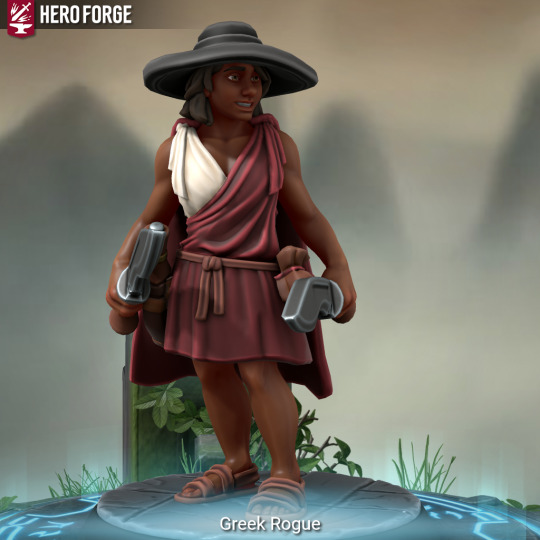
Symaethis the rogue, granddaughter of Hermes. Heiress to a long line of Rhodian pirates, Symaethis grew up sailing and plundering, raiding merchant ships and sea-side towns. Slick with dagger, kopis, and sling, she became captain of a corsair penteconter war-galley at seventeen. Despite her cunning, her ship ran afoul of Ionian triremes off the coast of Samos. Galley split in half and crew slain or drowned, Symaethis was rescued by Telesilla and Andromakhe, joining their band shortly after. https://www.heroforge.com/load_config%3D14939130/
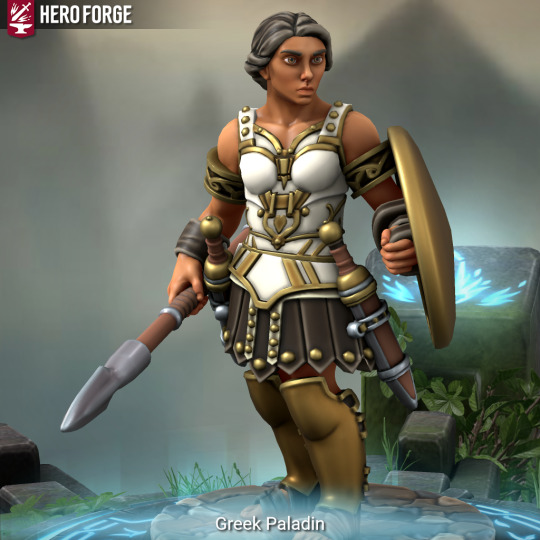
Lotis the paladin, transgender daughter of Apollo. Though a daughter of Apollo, Lotis instead swore her oath not to a god, but to Soteria, the personification of protection and safety. Born in Thebes, Lotis fought as a hoplite at the side of the famous Sacred Band in her youth and participated in their defeat of the Spartans. Now a free agent, she travels beside her friends, helping people from different parts of the Aegean. https://www.heroforge.com/load_config%3D14938815/
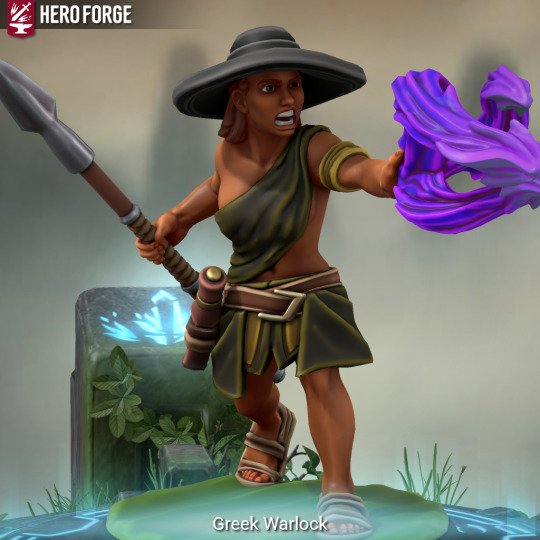
Nikia the warlock, granddaughter of Hekate. Though trained as a priestess to Persephone, Nikia instead found a patron in Bia, the spirit of force and energy. Often chaotic and easily angered, she loves her girlfriend Pelopia and cares deeply for her friends. Indeed, Pelopia’s kindness and free spirit seems the only thing that consistently tames Nikia’s fury and imbalance. https://www.heroforge.com/load_config%3D14940052/
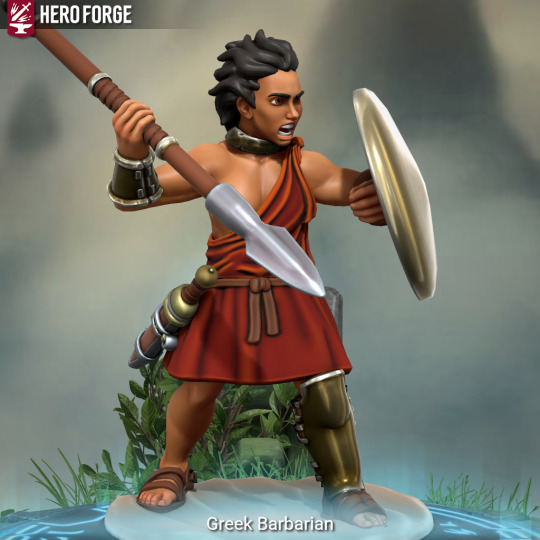
Euryleia the barbarian, granddaughter of Enyo. A Thracian, Euryleia grew up with spears and javelins. Something of a failure as a hoplite, she prefers relying on her own strength and prowess over depending on the support of others. Despite this, she seems to fight well beside her friends and enjoys helping others more than she’d expected. https://www.heroforge.com/load_config%3D14920727/
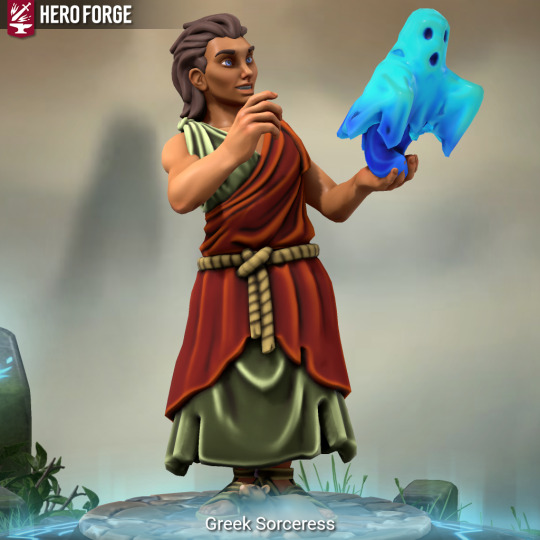
Pelopia the sorceress, daughter of the grace Aglaea. Gifted with a talent for illusions, Pelopia loves showing off her magic and making people laugh and smile. Though her relationship with Nikia seems counterintuitive on the surface, Pelo’s joy and kindness does much to calm Nikia’s instability. Where Nikia’s aggressiveness ruined her previous relationships, her love with Pelopia is filled with only smiles and laughter. https://www.heroforge.com/load_config%3D14939498/
26 notes
·
View notes
Link
New article from Philomαtheia! (available in multiple languages, just press “Translate” and select yours)
Telesilla: The female general that led Argos to victory at 494 BC.
To recieve email notifications, just subscribe via email (top of the page).
For any kind of business collaborations feel free to commuanicate at the Communication Section (bottom of the page).
Thank you, and enjoy your time!
#philomαtheia#blogger#dailyblogger#greek bloggers#philology#greek philology#history#greek history#telesilla#ancient greece#ancient god#great women#wars#ancient warriors
3 notes
·
View notes
Text
New favorite ancient Greek festival: The Hybristica of Argos, where women and men would exchange clothes and fight. The festival was in remembrance of Telesilla, who was said to have fought the Spartans, together with some other women, to defend her city.
37 notes
·
View notes
Video
tumblr
HAPPY World Poetry Day!
Read more about some of the famous poets throughout history here:
Sappho of Lesbos: worldhistory.org/Sappho_of_Lesbos/
Telesilla of Argos: worldhistory.org/Telesilla_of_Argos/
Hafez Shiraz: worldhistory.org/Hafez_Shiraz/
Chretien de Troyes: worldhistory.org/Chretien_de_Troyes/
Bai Juyi: worldhistory.org/Bai_Juyi/
57 notes
·
View notes